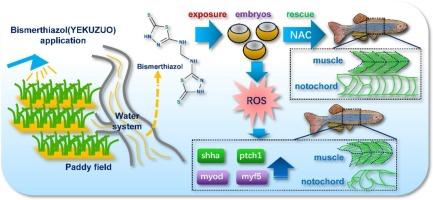Acute toxicity effects of rice paddy bactericide bismerthiazol on zebrafish (Danio rerio) embryos
IF 4.3
3区 环境科学与生态学
Q2 BIOCHEMISTRY & MOLECULAR BIOLOGY
Comparative Biochemistry and Physiology C-toxicology & Pharmacology
Pub Date : 2025-07-25
DOI:10.1016/j.cbpc.2025.110303
引用次数: 0
Abstract
Bismerthiazol is an extensively utilized agricultural bactericide in paddy fields. However, its toxicity to aquatic animals remains poorly understood. Through acute exposure of zebrafish (Danio rerio) embryos, we determined that the 72 h half-lethal concentration (LC50) of bismerthiazol was 7.38 mg/L, and 3 mg/L bismerthiazol induced systemic developmental abnormalities. Further studies showed that low concentrations (25 ng/L, 50 ng/L) of bismerthiazol selectively impaired notochord and muscle development in embryos and reduced their motility. Additionally, bismerthiazol exposure upregulated the Sonic hedgehog (SHH) signaling pathway and myogenic gene expression. It also increased reactive oxygen species (ROS) levels while decreasing the enzymatic activity of catalase (CAT), glutathione (GSH), and superoxide dismutase (SOD). Notably, the antioxidant N-acetylcysteine (NAC) rescued the bismerthiazol-induced notochord and muscle defects. In summary, our findings demonstrate that acute bismerthiazol exposure causes developmental toxicity in aquatic organisms by inducing oxidative stress, highlighting its potential ecological risk.

水稻杀菌剂双硫噻唑对斑马鱼胚胎的急性毒性研究
双噻唑是一种广泛应用于水田的农业杀菌剂。然而,它对水生动物的毒性仍然知之甚少。通过对斑马鱼胚胎的急性暴露,测定了双硫噻唑72 h半致死浓度(LC50)为7.38 mg/L, 3 mg/L双硫噻唑可引起全身发育异常。进一步的研究表明,低浓度(25 ng/L、50 ng/L)的双巯唑选择性地损害了胚胎脊索和肌肉的发育,降低了它们的运动性。此外,双巯唑暴露上调了Sonic hedgehog (SHH)信号通路和肌源性基因表达。它还增加了活性氧(ROS)水平,同时降低了过氧化氢酶(CAT)、谷胱甘肽(GSH)和超氧化物歧化酶(SOD)的酶活性。值得注意的是,抗氧化剂n -乙酰半胱氨酸(NAC)挽救了双美噻唑诱导的脊索和肌肉缺损。总之,我们的研究结果表明,急性双噻唑暴露通过诱导氧化应激导致水生生物发育毒性,突出了其潜在的生态风险。
本文章由计算机程序翻译,如有差异,请以英文原文为准。
求助全文
约1分钟内获得全文
求助全文
来源期刊
CiteScore
7.50
自引率
5.10%
发文量
206
审稿时长
30 days
期刊介绍:
Part C: Toxicology and Pharmacology. This journal is concerned with chemical and drug action at different levels of organization, biotransformation of xenobiotics, mechanisms of toxicity, including reactive oxygen species and carcinogenesis, endocrine disruptors, natural products chemistry, and signal transduction with a molecular approach to these fields.

 求助内容:
求助内容: 应助结果提醒方式:
应助结果提醒方式:


